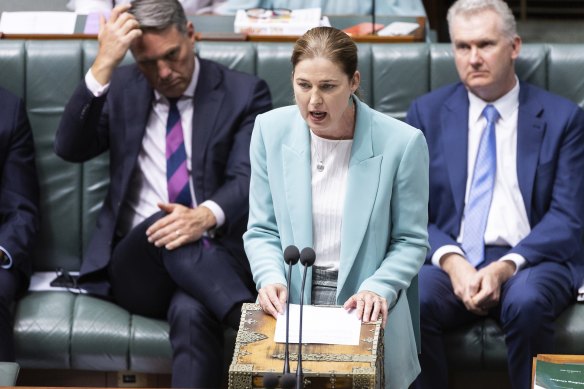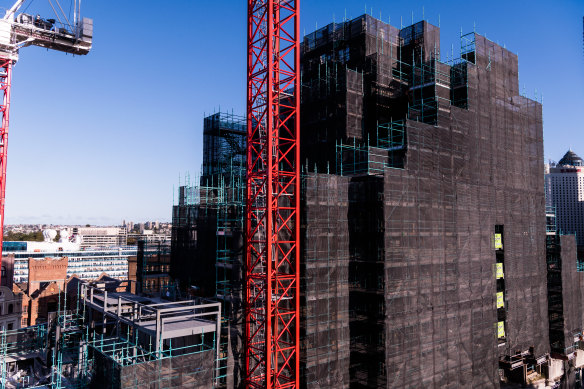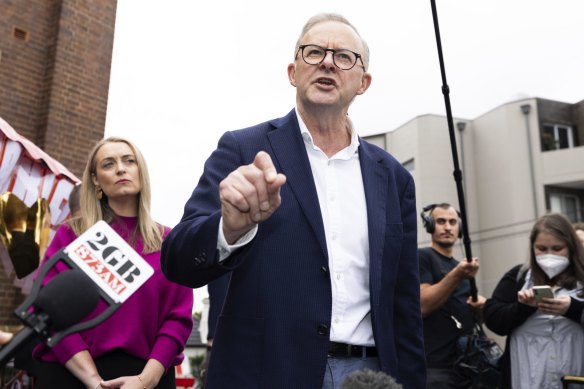This was published 1 year ago
Opinion
The PM grew up in social housing. His future fund won’t help those still there
Tone Wheeler
Australian Architecture Association presidentThey say those who ignore history are condemned to repeat it. When it comes to social and affordable housing, it seems the Albanese government – with its Housing Australia Future Fund – is content to disregard the lessons of the past.
Traditionally, public housing has been provided by the states and built with federal taxes. When poverty increases – after wars and crises – most countries increase public housing, but not in Australia, where those opportunities have been missed, or misused, time and again.

Housing Minister Julie Collins is responsible for the government’s proposed $10 billion housing fund.Credit: Alex Ellinghausen
These failures reveal three salient issues for the current debate about federal Labor’s housing policy: we premiate home ownership, we rarely build enough public housing, and when we do, we are all too prone to sell it off.
The first publicly owned rental housing was created by the Sydney Harbour Trust when it acquired houses in The Rocks and Millers Point for waterside workers after the 1900 bubonic plague.
In 1912, the NSW Housing Board planned the first “garden city” public housing estate in Australia. But at the same time, the NSW government also legislated control of deposits and mortgage financing for workers to own homes.
In 1919, the federal government established the War Service Homes Commission, which offered low-interest loans to returned servicemen to construct, or buy, a house. In the late 1920s, the NSW Housing Board was disbanded. Those directions were reversed when the Great Depression brought forth public housing through housing commissions and trusts in the eastern states, but Labor prime minister Ben Chifley proffered the Commonwealth Housing Commission to promote house sales to low-income workers.

Former public housing building Sirius is being redeveloped into luxury apartments. Credit: James Brickwood
After WWII, the Commonwealth State Housing Agreement (CSHA) made loans to the states for public housing construction, a system which continues in various forms to this day. In NSW and Victoria, the focus was on slum clearance. In just 10 years, state housing authorities built almost 100,000 dwellings for public rental – one in every seven dwellings built in Australia – and public housing, as a share of dwelling completions, reached 16 per cent.
The majority were detached houses in middle and outer “garden city” suburbs where antisocial behaviour thrived when public housing was too concentrated. Less in number, but more visually prominent, were flats in inner Sydney and Melbourne: three-storey walk-ups and towers.
In 1946, the Victorian Housing Commission repurposed the Commonwealth Tank Factory to produce prefabricated concrete panels – used in 27 towers across 19 suburbs in Melbourne – which, along with similar projects in Sydney, were vilified for their stark visual presence and beset by violence, drugs and suicides.
The Menzies government redirected 30 per cent of CSHA funds to building societies and state banks to finance home ownership, and the states sold off public housing. Sometimes more was sold than built in a year. By 1969, the NSW Housing Commission had sold almost 100,000 dwellings, one-third of all dwellings they built. Public housing was 7 per cent of all dwellings at the end of the 1980s.

Anthony Albanese has often recounted the story of his upbringing in public housing.Credit: Alex Ellinghausen
Three Labor deputy leaders have tried to reverse the trend: Tom Uren brokered a deal with state and local governments for public housing in Glebe and Woolloomooloo; Brian Howe developed the Local Government and Community Housing Program to provide public housing to marginalised groups; and Tanya Plibersek developed a comprehensive plan for inter-governmental co-operation and funding to reverse privatisation. But each successive conservative government has cut CSHA funding and rolled back the initiatives. The Commonwealth lost interest in public housing, which fell to 5 per cent of all dwellings in the late 1990s.
After the millennium, privatisation of public housing took off. Existing low-scale projects were sold for redevelopment at higher densities. In return, developers were compelled to set aside a percentage of new dwellings, about 15 per cent, for social and affordable housing. Public housing was rebadged, run by community housing providers, not governments.
The Berejiklian government took to it with alacrity, selling off the public housing at Millers Point, together with the 1980s purpose-built Sirius apartments. Social housing numbers often failed to increase, or even match, the public housing that had been lost, which falls to just 4 per cent of the dwelling stock now.
Today’s rising property values, falling home ownership and greater wage disparity sees 10 per cent of all households seeking social and affordable housing. That’s more than three times the social dwellings currently available. State Labor governments all have plans with various levels of ambition, but most are starved of funds, and want a better-funded CSHA, intensifying the current housing policy debate.
Federal Labor has responded with the Housing Australia Future Fund, where dividends will pay for 30,000 new social dwellings over five years. The need, according to the Greens and many housing demographers, is more like 50,000 each year for 20 years, a tall order when we build less than 100,000 per year now.
The federal government is crying poor: with a very low tax/GDP ratio it lacks income to address the accumulated debt and demands for the NDIS, defence and submarines.
Anthony Albanese tells the story of his upbringing with a single mum on welfare in public housing, but in denying funding for those social programs for current battlers it seems social housing is not a priority for the federal Labor Party. Instead, it invents a defective magic pudding, and puts an inexperienced minister – Julie Collins – in charge of it.
More than 120 years of governments advocating for middle-class home ownership, rather than public housing, has finally caught up with us. A bold vision, supported by funding, is needed, or we’ll have yet another public housing policy failure, this one of epic proportions.
The Opinion newsletter is a weekly wrap of views that will challenge, champion and inform your own. Sign up here.